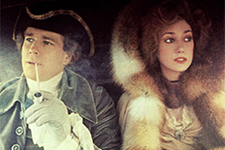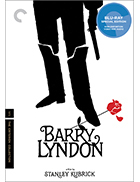Barry Lyndon
|  Stanley Kubrick’s Barry Lyndon opens with what is arguably the most beautiful shot in all of his films and, quite possibly, one of the most beautiful shots in all of cinema. A long shot depicting a duel, it is framed by massive trees and cut through with a winding, ancient-looking rock wall and wooden fence that extend into the depth of the frame, moving past a quintet of figures in the distance. They stand in a yellowish field, with purple mountains rising above them to a dramatically overcast sky. The interplay of light and dark, various contrasting colors, and extreme variation in the size of objects within the frame make it an endlessly fascinating composition in and of itself, but it also crucially establishes everything we need to know about how Barry Lyndon will unfold, which is in a most unconventional manner. The action in this opening shot, which is a single long take, is a duel in which the man who is killed is the father of the film’s protagonist. Viewing this opening moment of violence from an extreme distance establishes the film’s narrative tone, which is one of purposeful distance; rather than drawing us into the film’s world via grotesque close-ups as Kubrick did in several of his previous films, notably Dr. Strangelove (1964) and A Clockwork Orange (1971), Barry Lyndon is a film composed mostly of medium and long shots, which emphasizes the environment itself as much as it does the characters. There is a tendency to think that such an emphasis comes “at the expense” of the characters, but the underlying brilliance of Kubrick’s film is the manner in which he interweaves the two with such delicacy and affect and binds them together with a droll, omniscient narrator who supplies crucial information, frequently before events take place. Allowing us to know ahead of time what will eventually happen strips the story of the conventional pleasures of surprise, but that is a loss hardly felt as it is replaced with a constant sense of slow-burn suspense and intrigue as to how exactly the story will unfold. We know that characters’ fortunes will rise and fall, certain characters will die, and relationships will sour, and what is left to discover is the means by which these events take place, which is a unique pleasure all its own (although, to be fair, the narrative does allow for a few surprises, such as the revelation that a character we thought was killed in fact faked his own demise). Set in the second half of the 1700s, Barry Lyndon is based on William Makepeace Thackeray’s 1844 novel The Luck of Barry Lyndon, which was originally serialized in Fraser’s Magazine and was described by its author as “a novel without a hero.” The “non-hero” of the story is the eponymous Barry Lyndon (Ryan O’Neal), who is first introduced as a young man on the fringes of a prominent Irish family. His youthful romanticism and naïveté are forever destroyed when his cousin Nora (Gay Hamilton), with whom he is deeply in love, ditches him for a profitable marriage with the officious English Captain John Quinn (Leonard Rossiter). These events ultimately propel Barry out of his native Ireland, first into a stint of professional soldiering in the British army and then in the Prussian army during the Seven Years’ War. He is later recruited to spy on the Chevalier du Balibari (Patrick Magee), an Irish card shark who takes Barry under his wing and teaches him the ruthless tools of his mendacious trade. It is during this period of his life that Barry meets Lady Lyndon (Marisa Berenson), the beautiful wife of a dying lord whose place Barry means to take. And take it he does, which is how he achieves the title of Barry Lyndon, thus placing him near the top of the British social hierarchy. His incursion into the Lyndon family does not sit well with his stepson, Lord Bullingdon (Leon Vitali), with whom Barry is in constant conflict, first as a defiant child and later as a resentful young man who plots to undermine Barry’s position. The arc of the story is similar to the droog Alex’s course in A Clockwork Orange; it is a bitterly ironic accounting of a character’s rise and fall, although our relation to the protagonist is absolutely reversed. While Alex begins as a villain and gradually becomes a victim, Barry charts the opposite path, beginning as a victim of class hierarchies and slowly becoming a villain as he vanquishes them by ascending to their highest rungs. A further difference, however, is that Barry ultimately returns to victimhood, as the second half of the film recounts his rapid descent and expulsion from the world he worked so hard to infiltrate, partially due to his own vanity and desire for power and partially due to his decision late in the film not to kill someone when he has the chance. Thus, Kubrick doubles down on the irony of a poor Irish rake who manages to con his way to the top of the English aristrocracy only to tumble back down, the final stretch of which is caused by his one fully decent, humane decision. In the world of Barry Lyndon, kindness, decency, and forgiveness have little place. The world of the aristocracy, while seemingly refined and genteel, is its own pit of vipers, and if we feel anything for Barry, it is sorrow that his life’s pursuit was becoming one of them. Because Barry Lyndon is a story about social class and hierarchies, the use of architecture and space and environment is crucial to the characters’ development. Many critics at the time of the film’s initial release mistook Kubrick’s visual emphasis on painterly compositions and slow reverse zooms that turn close-ups of a detail (loading a gun, signing a document, fishing in a lake) into fastidious recreations of Renaissance and Romantic era paintings, accusing him of diverting the film’s attention and energy to its formal components at the expense of its characters and story. In fact, the environments themselves are constituent parts of the story, as they provide an expressive backdrop for Barry’s rise and fall; the expansive battlefields, gilded ballrooms, stately offices, and meticulously manicured gardens are characters in and of themselves, often conveying what is actually at stake in a way that is far more rich and direct than dialogue could manage. Kubrick had long been fascinated by this period in European history (he spent much of the late 1960s and early ’70s trying to mount a massive studio film about Napoleon that was ultimately doomed by budgetary concerns and worrisome studio executives). He conducted extensive research in order to recreate the era as closely as possible, which meant shooting in actual locations, using clothing that dated back to the late 1700s, and relying heavily on art from the period to learn about what life looked like. Working with cinematographer John Alcott, who had served as a lighting cameraman and assistant on 2001: A Space Odyssey (1968) and A Clockwork Orange, Kubrick achieved a visual palette that is intensely realistic while also resembling an oil painting in motion. Virtually every frame of the more-than-three-hour film is an expressive study in lighting and composition, and Kubrick insisted on the appearance of natural lighting, even at night when the characters’ world was illuminated only by flickering candles and candelabras. Capturing images in such low light levels required the use of special Zeiss lenses that had been specifically manufactured for NASA to use on its satellites. They fulfilled Kubrick’s need for lenses that would be 100% faster than any existing motion picture lenses, which meant that he and Alcott were able create imagery that previously would have been literally impossible to capture. Barry Lyndon brought the movies that much closer to human eyesight. Kubrick’s decision to make an ornate historical film following three forays into futuristic science fiction seemed odd and unexpected at the time, but for Kubrick it made perfect sense. In a 1976 interview with Michel Ciment, Kubrick noted, “It … offered the opportunity to do one of the things that movies can do better than any other art form, and that is to present historical subject matter. Description is not one of the things that novels do best but it is something that movies do effortlessly, at least with respect to the effort required of the audience. This is equally true for science-fiction and fantasy, which offer visual challenges and possibilities you don’t find in contemporary stories.” Thus, in Kubrick’s mind, the landscapes, modes of dress, language, and customs of pre-Napoleonic Europe are just as alien—and fascinating—as a dystopian future London or an orbiting space station. And this is precisely why Barry Lyndon, despite the largely negative critical reviews that greeted its arrival in theaters, has only grown in esteem over the years, with many now proclaiming it Kubrick’s best work. Far from the cold, unengaging exercise in historical style it is often accused of being, Barry Lyndon is a deeply felt, sometimes brutally ironic, and always visually gorgeous summation of the wide breadth of human experience—from the profound to the profane, the absurd to the abject, the hopeful to the miserable.
Copyright © 2017 James Kendrick Thoughts? E-mail James Kendrick All images copyright © Warner Bros. / The Criterion Collection | |||||||||||||||||||||||||||||||
Overall Rating: 


 (4)
(4)


